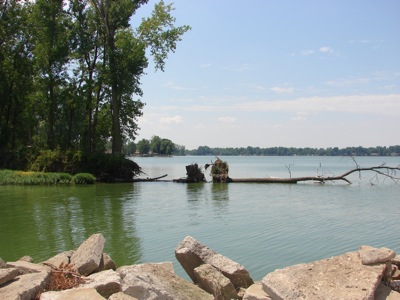Saturday, August 4th, 2007
Lake islands vanishing but not the history behind them
By Janie Southard

Photo by Janie Southard/The Daily Standard
This house on Dayton Island on Grand Lake is on a 99-year lease from the state to a Brookville man, who has spent a lot of time and energy ferrying riprap out there to protect the island
ST. MARYS - There used to be Grassy, Elm, Squaw Point and Smoke Eaters, but now they're gone. Duck Blind is still around as are several with no names and even one with a cottage.
But the largest remaining island in Grand Lake is Prairie Creek Island, off the south central shoreline.
Grassy and Smoke Eaters islands, each less than an acre, were visible in the mid-1960s but with no trees or any other shoreline protection system they just eroded away, said Grand Lake St. Marys State Park Assistant Manager Brian Miller.
People still want islands and are even willing to pay to create their own.
"In the past seven years, I've had a lot of calls from people who want to build an island here or lease one. I wouldn't rule it out in the future, but for right now we're not allowing anything like that," Miller said recently.
He added that building islands in Grand Lake has been under consideration by the state for many years as a means of preserving shoreline and existing islands by slowing down wave action.
"But it all boils down to money. We just can't afford to build any islands until we can preserve what we have," Miller said, adding that Grand Lake includes 52 miles of shoreline and a fair number of islands right now.
Private owners of shoreline have done a good job of protecting their property with riprap (large rocks) as has Patrick Elder, of Brookville, who holds a 99-year lease from the state on Dayton Island, the only island with a home on it. The white cottage is almost hidden on the tree-covered island which spans approximately 1.5 acres.
"He spent much of last summer ferrying riprap back and forth on a pontoon boat out to his island," Miller said.
There's Safety Island, located in the middle of the lake, which Miller said is used as a haven for stranded boaters when storms mount quickly over the shallow lake.
But, way back when, the island had an another purpose. Retired dredge operator Howard LeCompte of Celina recalled a story he heard from another state park employee, Howard Palmer.
Back in its prime, Safety Island was fairly substantial, with more than 40 acres of tillable land. So tillable, in fact, the state routinely planted corn on it.
"Howard told me they used to use a dredge to get the equipment out there and then swim a team of horses out to do the plowing," LeCompte said.
Eileen Deeter of Montezuma, wife of the late David Deeter, a former assistant park manager in the mid 60s, said she'd never heard that story, but had a few of her own to tell.
Deeter, 82, and her husband were avid duck hunters, as were most of their friends, such as "Snowball" Urban and Don Leitzel, both now deceased.
"Now those two had a running rivalry every year about who would get out to Safety Island to set a (duck) blind," she said from her cozy home at the end of a channel on the lake's south side.
It seems blinds were established on a first-come, first-served basis back in the 1940s and 50s. Today it's by a state-guided lottery system.
"Well, Snowball would row out to Safety Island and that's quite a long way to row a boat I'm telling you. He and his buddies would set up and then stay out of sight.
"Along comes Don also rowing that long way and there'd be Snowball all set up. I can't count the times that happened, and each time Don would come back to shore waving his arms saying 'You just can't beat those SOB's,' " Deeter recalled, still laughing after all these years.
The small island still known as Rock Pile, where the last oil rig on the lake sat, brings forth another Deeter recollection that she swears happens every year.
"Every year around the Fourth of July holiday there are crappies by the hundreds off that little rock island. What happens is that they begin working to the east end (of the lake) shore, then up the south side and around the Fourth holiday they've managed to get to the deeper water ... It never fails," she said with a bit of a twinkle in her eye.
She and LeCompte both claim the former Goat Island was named for a certain herd of, yes, goats. (Well, LeCompte said they could have been sheep. Deeter said "no way.")
The Deeter story goes that someone - she's not saying who - loaded up several goats in a boat and took them out to a little grass- and weed-covered island just off the southeast side of the lake.
"He had the idea the goats could keep the island neat and tidy. Goats will eat anything, you know. Eventually, the goats were causing their own problem out there, if you know what I mean. So the state guys went out there and somehow got those goats to get in a boat again and took them to shore," she said.
It is thought some lucky south side farmer ended up with several nice, fat island goats. That's Deeter's thought, anyway - and it makes sense.
After all, how many places are there you could take a boatload of seasick goats?

Photo by Janie Southard/The Daily Standard
Trees are a form of ground support structure on islands. Wave action erodes the shore, weakens the root system and trees like this one, from an island just off Windy Point, topple into the lake. Another type of shoreline protection is riprap (large stones) seen in the foreground.


